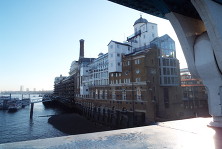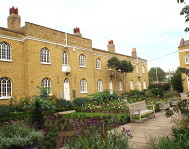








A public library had already opened near Camberwell Green in 1893 but with the population increasing the North Camberwell Radical Group campaigned for a second library in North Camberwell. A swimming pool and baths had been built in the 1820s between Addington Square and the newly constructed Grand Surrey Canal but, perhaps because the buildings were deteriorating, it was decided to build new baths and a wash-house on the same plot as the new library. Land adjacent to the Grand Surrey Canal on what was then called Wells Street was donated by John Rolls, 1st Baron Llangattock. His great-grandfather, John Rolls of Bermondsey, had married well, his wife, Sarah Coysh, inheriting lands in both London and Monmouthshire. The name Rolls lives on as half of one of the most famous partnerships in the world as it was Llangattock’s son Charles who with Henry Royce founded Rolls-Royce Limited.
John Passmore Edwards who had already donated money to build libraries at Dulwich, Nunhead and Borough Road in Southwark agreed to pay the building costs of the new library. Born in Cornwall of modest parents in 1823, John Passmore Edwards was a remarkable man. He became a voracious reader and developed a desire both for self improvement and “an ambition to be useful” in his childhood and by hard work and zeal became a wealthy and influential man, never forgetting his desire for reform and helping others up the ladder. From the 1890s onward he funded the construction of 71 public buildings which apart from libraries included buildings for education, the arts, health and for orphans and the disabled. As well as funding libraries in Southwark, Passmore Edwards also donated money to build what became the Camberwell College of Art and to expand the South London Gallery. More can be found out about his life and works here and the author of that piece, Dean Evans, has also written a book "The Passmore Edwards Legacy” which is highly recommended.
Lady Llangattock laid the foundation stone for the Public Baths and Wash-houses and John Passmore Edwards the foundation stone for the Library in a joint ceremony held on 25 July 1901. The Times describing the event reported “The library will comprise a newspaper reading room, a reference reading-room and a lending library. The baths will accommodate 50 slipper baths in four compartments, and the laundry will provide for 30 washers at one and the same time. There will be a mangling room and every convenience. The cost of the building, exclusive of the engineering work and the value of the site, is estimated at over £18,000.” A junior library opened in 1925 in one of the basement store rooms of the Library.
The Public Baths closed in 1981 and has been home since then to the Lynn AC Boxing Club, Britain’s oldest continuing boxing club. The library closed in 1991 and while the Friends of Burgess Park are seeking a permanent use for the building, it is currently being used as an arts pop-up.
North Camberwell Library, Baths and Wash-house
North Camberwell Library is on the left of the building and the Baths and Wash-house on the right.
The most striking part of the building today is the mural made from Doulton tiles depicting a Camberwell Beauty butterfly on the wall of the wash-house. While it looks like it’s been there forever, it was only installed in 1982 when its original home, the factory of stationers Samuel Jones & Co in Southampton Way, was demolished and the company moved away. The company specialised in gummed papers and adhesives and adopted the butterfly as its logo in 1912
to demonstrate multi-colour printing. The company won a contract to apply gum to the rear of postage stamps in the 1920s and by the 1960s employed 2,700 people. More can be found out about Samuel Jones & Co here.
Commemorative trowel used by John Passmore Edwards to lay the foundation stone at the North Camberwell Library (on temporary display at the new library Camberwell Green)
It may be hard to imagine now but when built at the beginning of the 20th century, the building that used to house the North Camberwell Public Library, Baths and Wash-house was at the centre of a bustling community and integral to a network of roads, houses and factories. Today, the building is one of just a few that survived bombs from the second world war, slum clearance and the formation of Burgess Park, and stands almost in isolation in Wells Way, Camberwell.
Web discoveries
- UK Casino Not On Gamstop
- UK Casino Not On Gamstop
- Non Gamstop Casino
- Casinos Not On Gamstop
- Non Gamstop Casinos
- Non Gamstop Casinos
- Non Gamstop Casino
- Casino Sites Not On Gamstop
- Slots Not On Gamstop
- Casinos Not On Gamstop
- UK Betting Sites Not On Gamstop
- UK Casino Not On Gamstop
- Best Non Gamstop Casinos
- Betting Sites
- Non Gamstop Casino Sites UK
- Best Non Gamstop Casinos
- Non Gamstop Casino
- Casinos Not On Gamstop
- Non Gamstop Casino Sites UK